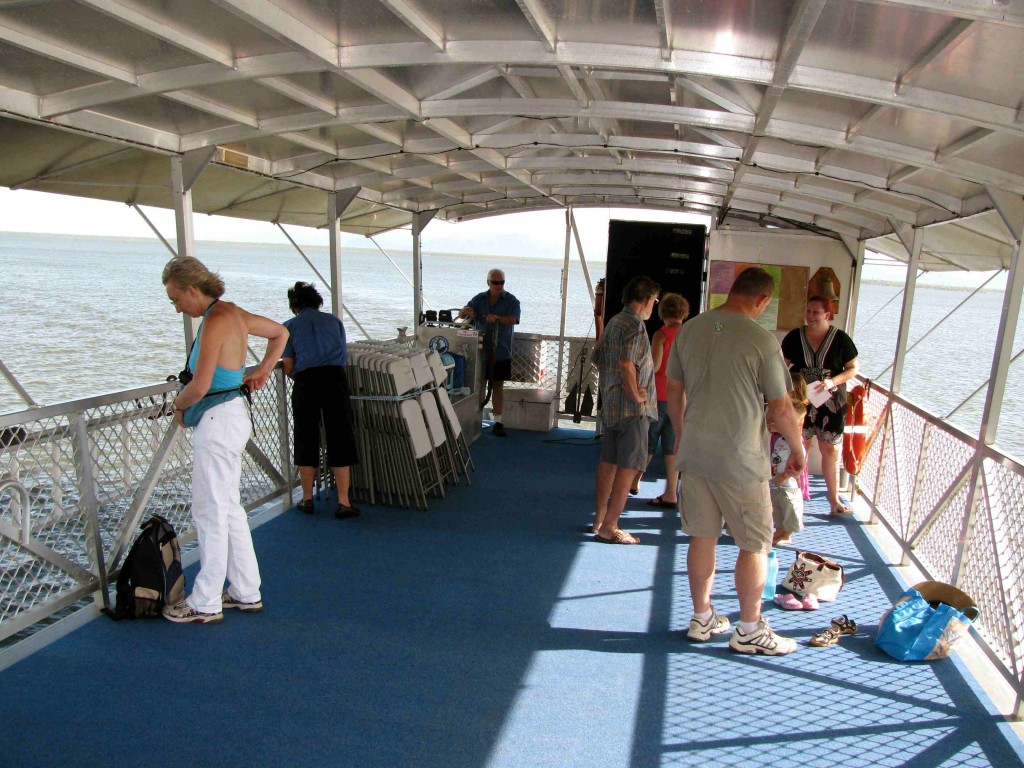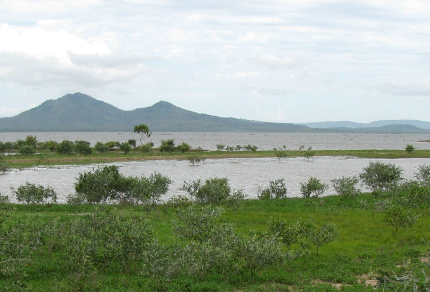
Ross Lake Cruise Boat (© Vilis Nams)
Thunder rumbled overhead, and Mount Stuart was capped by leaden clouds when Vilis and I arrived at Ross Park at 1:45 p.m. A few minutes later, the tour operators for our Lake Ross cruise drove up. They were a couple in their late fifties or early sixties, Pop Sullivan and his wife Heather. We and six other guests – a couple with a little girl and boy, plus the children’s grandparents – followed the tour operators’ Yamaha mini-jeep up the steep track onto the Ross River Dam, through the gates guarding access to the spillway, and off the dam onto a rough road bordering the lake.
The recent heavy rains had noticeably increased the volume of the lake, which is a huge reservoir that supplies Townsville with most of its water. Last weekend, following the deluges of the tropical monsoon low that descended onto Townsville, the lake was over-capacity, and all three of the dam’s spillways had to be opened to release the excess water into the Ross River.1 It’s no wonder the water pounding over Aplins Weir, the third of the city’s three weirs below the dam, had reached the level of the pedestrian and cyclist bridge on Saturday.
Onboard the MV Kathleen Mary with its shading canopy, the warm breeze over the lake was a delight. Sheets of grey rain hung over green hills to the north, and beneath the cloudy sky, the lake water appeared as strips of green and grey. As we headed across the 2 kilometres of water that would take us to entry point of the Ross River, the tour operators split the tour duties, Pop guiding the boat and providing historical information over a loudspeakerwhile Heather served a light snack of finger foods and chatted with the passengers.
Having brought my binoculars and bird book, I was glued to the railing for most of the trip, but I did hear that the first version of the Ross River Dam was completed in 1976, and that renovations to increase its capacity were finished in 2007. I also heard that a Scot by the name of Kelso came looking for gold and ended up owning a couple million acres of land. Vilis told me another bit of information he’d picked up, but which had gone right past me. It was that until the dam was built, Townsville’s main source of water was the hills around Paluma. Hence the white pipelines we had observed en route to Paluma on January 3.
As during our walk along the top of the dam on January 24, I spotted many darters or snakebirds, the first on a floating log and others on dead treetops protruding from the lake or stumps along the shore. Pelicans swam both in grassy shallows and out on the deep water of the lake. Pied cormorants perched on dead trees in the water, and a surprising number of whistling kites – brown hawks with tawny heads and dark brown flight feathers – perched on floating logs or high in tall eucalypts along the shore of the wide river mouth. I spotted two stick nests in trees, with whistling kites nearby, and watched one whistling kite slash at a black kite with its talons when the black kite dive-bombed it in the air.
At the side of the river, we saw huge yellow dredges that work the river during the dry season, dredging sand and gravel to sell and at the same time preventing the river and lake from accumulating heavy silt loads. A pair of hardhead ducks flew overhead, and a blue-winged kookaburra perched motionlessly in a gum tree at the edge of the river, which near the dredges was 15 metres deep according to the boat’s depth sounder. Her captain pointed out a low ridge bordering the river and told us that, in the 1880’s, the Queensland government drilled bores along the ridge, which was much higher before the valley was flooded, and constructed concrete watering troughs to provide water for travelers using an outback road along the ridge, and for their horses. The blades of a windmill long ago fallen to the ground stuck out of the vegetation like a half-circle of rusting, blue-grey paddles.
Leaving the river, we entered one of its tributaries, Round Mountain Creek, a shallow stream 30 to 40 metres across bordered by thick groves of paperbarks inundated by high water. Our guide told us, “If you’re ever going to see a crocodile, this would be the place to see it.” A freshwater crocodile, he clarified, and we looked hard at the pale green water and among the flooded trees, but saw none.
On our return run up the Ross River, the cruise boat pulled into shore along the ridge on which the bores had been drilled, and we had the chance to stretch our legs by walking to the top of a small hill. From there, we looked out over the vast expanse of Lake Ross, on which I spotted black swans, pelicans, and a host of gulls in the distance. Beyond the lake, hills resembling the cusps of teeth gnawed at the sky.

Ross Lake (© Vilis Nams)
Out on the open lake again, the boat slammed into waves kicked up by a strong north wind. The two young children lay on the carpet, looking out at the water. I was constantly surprised by how observant the little boy was. He frequently announced to his parents and grandparents his latest finding, the most exciting of which was a slender, green-faced, brown snake on the boat’s ladder attached to the railing. His mother, on seeing the snake, said, “The only good snake is a dead one.” Heather, who told us she thought it was some kind of tree snake, nimbly picked it up by its tail and threw it into the lake. When the boy asked what had happened to the snake, she told him it had gone for a swim.
On our return to our car, I looked through my reptile guide and identified the snake we had seen as a common tree snake, one of Australia’s two species of tree snakes. Both are harmless. 2
References:
1. Lydia Kellner. City mops up. Townsville Sun. Wednesday, February 3, 2010. p. 3.
2. Steve Wilson and Gerry Swan. A Complete Guide to Reptiles of Australia. 2003. New Holland Publishers (Australia) Pty Ltd, Sydney, p. 410.


